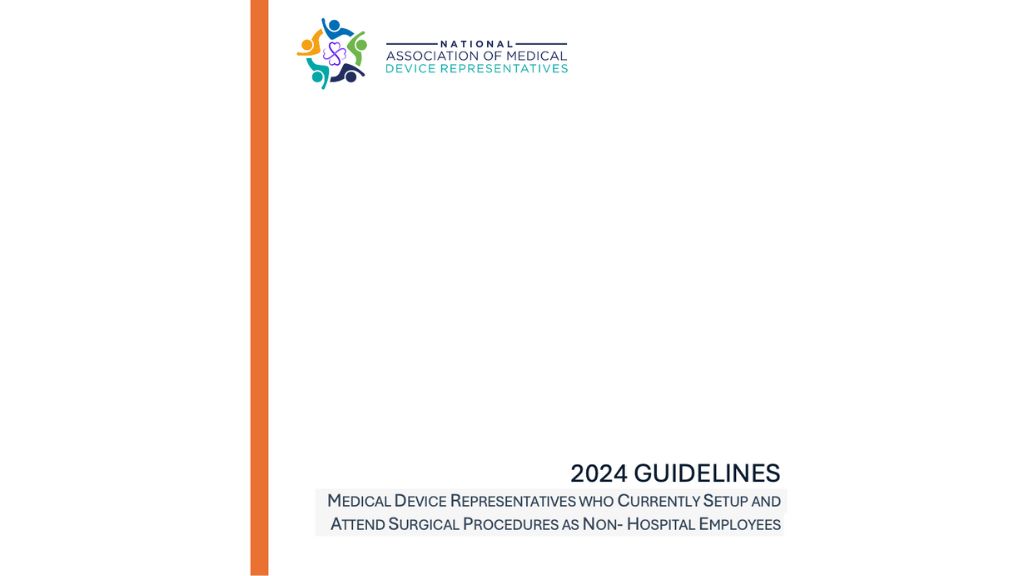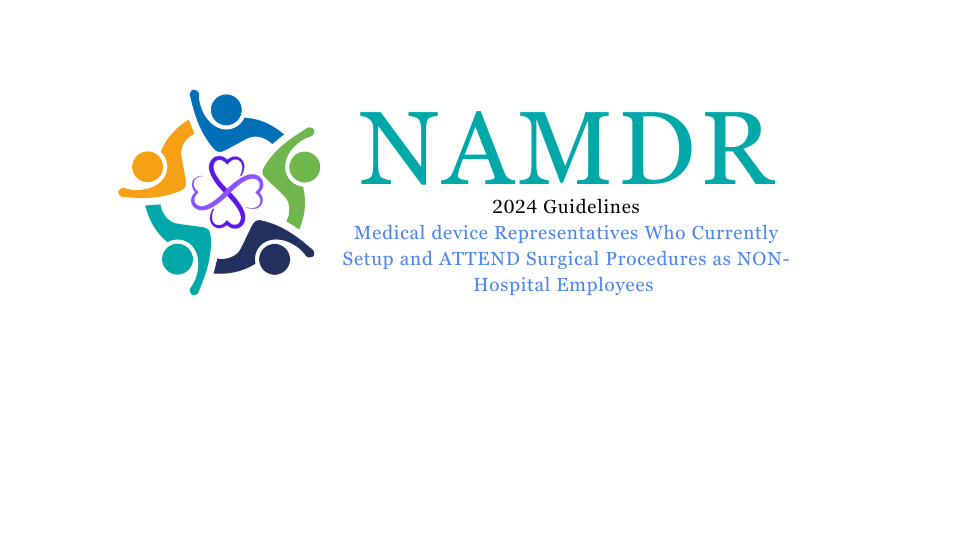Patient Safety Starts when Surgical Trays are delivered:
2024 Guidelines for Healthcare
Organizations who use Non Hospital employees called Medical
Device Representatives to Setup Surgical Instruments and Implants and Attend Surgery
Some healthcare facilities may choose to use Certified Medical Device Representatives who are educated on the National Association of Medical Device Representatives (NAMDR) Guidelines. Patient safety starts with how surgical instruments arrive at a healthcare facility and the care and setup involved.
Does your facility strive to receive an A Plus Medicare rated facility?
Is your healthcare facility committed to achieving the highest standards in patient safety and surgical excellence? Does your Healthcare Facility currently use Certified Medical Device Representatives? These comprehensive guidelines are for healthcare facilities as reference to establish their own policies which may require a policy change to require certification for Medical Device Representatives (MDRs) to the NAMDR guidelines. By ensuring that every MDR supporting your surgical teams is thoroughly trained and certified, you can elevate the level of care provided in your facility.
2024 Guidelines
Certification for MDRs or CMDR:
- Emphasizes the importance of MDR certification to ensure that representatives are knowledgeable and skilled. Vendor Credentialing is not Certification.
- Enhances patient safety and surgical outcomes through rigorous training and certification.
Efficient Surgical Tray Management:
- Detailed protocols for managing surgical trays, covering consignment and loaner surgeries, delivery timelines, and the Ready For Surgery Surgical Tray management system.
- Ensures smooth and safe operations within surgical environments.
In-Depth MDR Conduct Guidelines:
- Strict procedures from setup to post-surgery, ensuring adherence to the highest standards of patient safety.
- Empowerment of surgical teams with knowledge on the proper FDA-cleared use and cleaning of medical devices.
Integration with NAMDR Guidelines:
- Seamless integration of NAMDR guidelines into hospital policies and updated vendor credentialing requirements.
- Ensures that your facility meets the highest standards of safety and efficacy.
Authored by Industry Leaders:
- Provides reliable, actionable insights tailored for healthcare organizations.
- Keeps you up-to-date with the latest guidelines and best practices in medical device representation.
Who Will Benefit from These Guidelines :
- Healthcare administrators
- Surgical center managers
- Hospital leadership
Why are the 2024 Guidelines important:
- Enhance facility policies and procedures.
- Ensure surgical teams are supported by certified and well-trained MDRs.
- Lead the way in patient safety and surgical excellence.
Order Now
Equip your healthcare facility with the knowledge and tools to lead the industry in patient safety and operational efficiency. Download your copy of "2024 Guidelines" today and take the first step towards a safer, more efficient, and more professional healthcare environment.

Need for Medical
Device
Representative
Certification
Currently, healthcare organizations operate with independent hospital policies regarding how Healthcare Industry Representatives (HCIR) function within their facilities. Vendors are identified as non-hospital employees, and the ANSI/NEMA SC 1-2020 standard is the only guideline for Vendor Credentialing, addressing vendor access requirements for Tier 1, 2, and 3 locations. Medical Device Representatives (MDRs), a subset of HCIRs, are classified as Tier 3, granting them access to sterile areas within healthcare facilities.
While ANSI/NEMA SC 1-2020 focuses on vendor access to facilities, it does not provide guidelines or standards for Medical Device Representatives who set up and attend surgical procedures as non- hospital employees. The National Association of Medical Device Representatives (NAMDR) recognizes this unmet need, emphasizing a focus on patient safety.
Currently, there are certification requirements for Pharmaceutical Representatives and Durable Medical Equipment (DME) representatives (wheelchairs, bone stimulators). However, there are no certification requirements for Medical Device Representatives who sell devices like pacemakers, human tissue and hips knees, despite their significant role in healthcare facilities, including setting up and attending surgeries. This gap highlights the need for specific standards and certification processes to ensure the safety and efficacy of medical device representatives' involvement in surgical procedures. While medical device companies may focus education on how to sell and proper use. Today there are no requirements and education for Surgical Case setup and tray management. A significant Patient Safety issue for non hospital and non certified employees.
To address this, NAMDR proposes updating the current educational requirements for a National REP™ registration number, HCIR Certificate (ANSI/NEMA SC 1-2020), and introducing the CMDR (Certified Medical Device Representative) certification. These certifications can be seamlessly integrated into existing Vendor Credentialing systems without incurring additional costs to healthcare facilities.
NAMDR is not focused on past indiscretions. Instead, we look to pave the way for a patient-safe future where Certified Medical Device Representatives have a safe, impactful, and collaborative future, working towards excellence and patient safety. By establishing rigorous certification standards and updating educational requirements, NAMDR aims to create a healthcare environment where Medical Device Representatives contribute positively to patient outcomes and uphold the highest standards of professionalism and safety.
